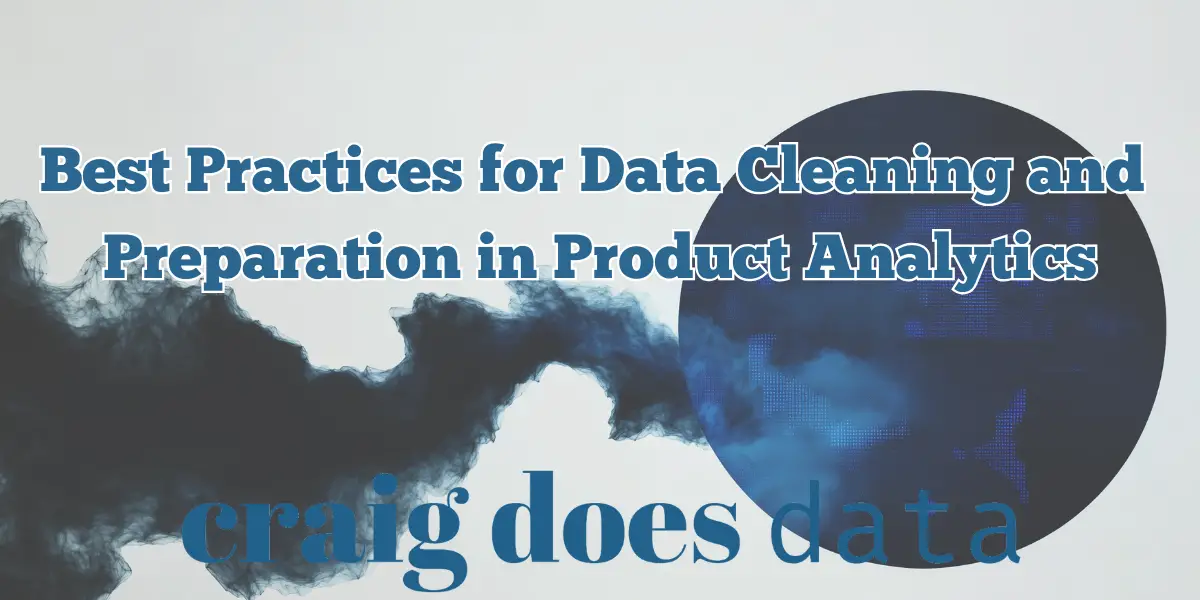Best Practices for Data Cleaning and Preparation in Product Analytics
Introduction
In today’s competitive digital landscape, product analytics plays a pivotal role in helping businesses understand how users interact with their products. Whether you’re managing a mobile application, a SaaS platform, or an e-commerce website, collecting and analyzing user data enables you to refine features, improve user experiences, and ultimately guide product strategies toward long-term success. However, the insights you glean from these analyses are only as accurate as the data you feed into your models and dashboards. This is where data cleaning and preparation step in to make a critical difference.
Data cleaning involves detecting and removing errors and inconsistencies in your raw dataset, while data preparation focuses on structuring, transforming, and standardizing the cleaned data for efficient analysis. When done correctly, these foundational steps ensure that your analytics outcomes are trustworthy and actionable. High-quality data can reveal patterns that drive growth strategies, inform product roadmaps, and enhance user satisfaction. On the other hand, flawed or poorly managed data can lead to misguided decisions, squandered resources, and missed opportunities.
In this article, we will explore best practices for data cleaning and preparation specifically within the realm of product analytics. By the end, you will understand how to systematically address data inaccuracies, integrate data from multiple sources, maintain privacy and security standards, and choose the right tools for your workflow. Whether you’re just beginning your journey in product analytics or looking to refine an existing process, the strategies outlined here will empower you to build robust, reliable datasets and unlock deeper, more meaningful product insights.
Section 1: Understanding Product Analytics

Product analytics is the systematic approach to evaluating how users interact with a product. It provides the framework for capturing data points, such as feature usage, session duration, user engagement patterns, and conversion metrics. These insights help product teams make decisions that directly impact user satisfaction and drive business growth. By interpreting user behaviors and trends, companies can optimize their offerings, enhance user retention, and launch new features that align with market demands.
At the heart of product analytics lies the data itself. Data can come from various sources, such as server logs, user surveys, application performance metrics, and third-party platforms like payment gateways or analytics services. Each source delivers a piece of the overall puzzle, coming together to help form a comprehensive view of how users progress through different stages of the product journey. This holistic perspective is invaluable for identifying bottlenecks, testing hypotheses, and experimenting with user-centric innovations.
However, product analytics is only as reliable as the data upon which it stands. Inconsistent or erroneous data can lead to misleading conclusions that derail product strategies. Imagine basing a critical feature rollout on inaccurate usage reports - time and resources would be wasted, and user trust could be compromised. Therefore, ensuring high-quality data is not just a technical endeavor; it’s a strategic necessity. Maintaining data integrity through rigorous data cleaning and preparation processes sets the stage for successful product analytics, shaping a product that truly resonates with its users.
Section 2: Importance of Data Cleaning in Product Analytics

Data cleaning is an essential first step in any analytics project, including product analytics, because it addresses the fundamental accuracy of the data. In a typical product analytics scenario, raw data streams in from various channels, such as mobile apps, web platforms, IoT devices, and third-party integrations. This raw data often arrives with numerous inconsistencies—duplicate records, missing fields, conflicting formats, or even corrupted entries. If these issues remain unaddressed, they can skew metrics, obscure meaningful trends, and lead analysts to incorrect conclusions about user behavior and product performance.
One common issue arises from the different conventions used across multiple data sources. For example, timestamps might be recorded in various time zones, or user IDs might be stored in contrasting formats. Another prevalent concern is missing values. User inputs may be incomplete, or certain system logs might fail to capture specific data points under particular conditions. Without a systematic approach to resolving these discrepancies, you risk injecting inaccuracies into your analytics pipeline.
The impact of poor data quality extends far beyond erroneous dashboards. Data inaccuracies can mislead product managers who might deprioritize important features or allocate resources to initiatives with minimal return on investment. In worst-case scenarios, entire product roadmaps can be based on flawed assumptions derived from unclean data. This not only wastes time and money but can also diminish team morale and user trust. When releases or updates fail due to misinformed decisions, the ripple effect can be detrimental: marketing campaigns may underperform, user churn rates may spike, and brand reputation can suffer.
Consequently, data cleaning isn’t just a checkbox in the analytics process—it’s a strategic imperative. Organizations that invest time and resources into a rigorous data cleaning regimen increase the reliability of their insights and make data-driven decisions with confidence. By identifying and fixing errors early, you create a more stable foundation for subsequent analyses, predictive models, and machine learning applications. This proactive approach ultimately leads to more robust product analytics outcomes, enabling teams to deliver better user experiences and achieve tangible business gains.
Section 3: Key Steps in Data Cleaning

3.1. Data Collection and Assessment
The data cleaning process begins before you even start removing duplicates or standardizing formats; it starts with data collection. Ensuring that you have robust mechanisms in place to capture accurate and comprehensive data is vital. For instance, consider implementing validation checks in your data collection forms so that users cannot submit malformed data. In product analytics, this might mean verifying that user IDs are correctly formatted, timestamps align with a specific standard (e.g., UTC), and numerical fields fall within expected ranges.
Once the data is collected, the next step is assessment. A data audit can help you understand the scale and scope of the inconsistencies within your dataset. This assessment often involves generating descriptive statistics or summary reports to spot anomalies. For example, if you discover that 20% of your user activity logs have null values in a critical field, it signals that either your logging mechanism is flawed or that certain user interactions are not being tracked properly. By identifying these gaps early, you can strategize how to address them in subsequent steps of the data cleaning process.
3.2. Handling Missing Data
Missing data is a pervasive challenge in product analytics, as real-world user activities rarely fit perfectly into standardized data capture processes. In some cases, you may not have the data at all (e.g., a particular analytical event was not implemented by the engineering team when a product was first launched), while in others the data is only partially available (e.g., some users chooses not to provide demographic information). A robust strategy for handling missing data can include several approaches: imputation, removal, or flagging. Imputation involves estimating the missing values based on known data—perhaps using the mean, median, or even more complex algorithms like k-nearest neighbors or regression models. Removal is simpler: you discard any records or fields that contain missing values, but this can risk losing valuable information if done excessively.
Another strategy is to flag missing values so that your analytics or machine learning algorithms can account for them separately. This approach is often useful in product analytics, where the pattern of missing data itself might reveal user preferences or product limitations. Whichever method you choose, it should align with the objectives of your analysis and the nature of your dataset. For instance, if you are analyzing user signup flow, missing email addresses might indicate drop-off points or user hesitations. Recognizing these nuances helps you make an informed decision about how to handle missing data appropriately.
3.3. Removing Duplicates and Inconsistencies
Duplicates can arise from multiple user signups, repeated logging events, or system errors. In product analytics, duplicate data may inflate metrics like user count or session frequency, distorting how you interpret product engagement. Identifying duplicates involves comparing key fields such as user ID, session ID, or timestamp. Some analytics platforms have built-in features to highlight potential duplicates, but you can also script this process using tools like Python, R, or SQL queries. Once identified, you must decide whether to merge duplicate records, remove them entirely, or flag them for further investigation.
Beyond duplicates, data inconsistencies can take many forms. You might notice variations in how values are labeled (e.g., “Sign-Up” vs. “Signup” vs. “Register”), making it difficult to group data in a uniform way. In numerical columns, there could be out-of-range values caused by system bugs or manual data entry errors. Addressing these inconsistencies often means establishing data dictionaries or reference tables that define acceptable values and formats. By systematically cleaning these irregularities, you eliminate hidden barriers to accurate analysis.
3.4. Standardizing and Normalizing Data
Standardization is the process of converting data into a consistent format, ensuring uniform units of measure, naming conventions, and data types. In product analytics, this might mean converting all currency fields into a single denomination or unifying date and time fields under the same time-zone standard. Normalization often involves restructuring the data to reduce redundancy and improve data integrity—commonly used in relational databases where tables are organized to minimize duplication.
Standardization and normalization go hand in hand to create a coherent, reliable dataset. When data is uniform, it becomes much easier to integrate multiple sources and run analytics that yield comparable insights. For instance, analyzing user activity across different platforms (mobile, web, or desktop) benefits from standardized event names and parameter structures. Likewise, normalized tables allow product teams to run complex queries without worrying about merging scattered or repetitive information. Overall, these practices ensure that data is accurate, consistent, and ready for the deep analysis required in product analytics.
Section 4: Preparing Data for Product Analytics

4.1. Data Transformation Techniques
Once your data is cleaned, the next step is to transform it into formats and structures that best serve your analytical objectives. Transformation can involve a wide range of operations, such as aggregating event-level data to daily or weekly summaries, filtering out irrelevant data points, or pivoting data tables to highlight user activity across different stages of the product lifecycle. In product analytics, transformations often focus on understanding user journeys, funnels, and key performance indicators (KPIs). By applying these transformations, you can make the data more interpretable and align it better with the metrics that matter most to your team.
4.2. Data Integration
A complete view of product performance typically requires data from multiple sources. For instance, you may have user interaction data in one database, sales transactions in another, and marketing campaign details stored in a third-party platform. Integrating these disparate datasets allows you to see the bigger picture—how marketing activities drive user engagement, how engagement correlates with in-app purchases, and which product features lead to the highest lifetime value. Merging these datasets effectively requires consistent keys (e.g., user IDs) and standardized data formats. Tools like ETL (Extract, Transform, Load) pipelines, data warehouses, and modern data orchestration platforms can streamline the integration process, reducing manual effort and opportunities for error.
4.3. Ensuring Data Privacy and Security
As you prepare data for product analytics, it’s paramount to maintain high standards of data privacy and security. This includes anonymizing or pseudonymizing user information where appropriate, complying with regulations like GDPR or CCPA, and implementing secure data storage and transfer protocols. Data breaches or unauthorized access can have severe consequences for both user trust and legal compliance. In addition, adopting a least-privilege access model within your analytics team ensures that individuals only have access to the data they need. These practices not only safeguard your organization but also foster a culture of responsibility, reinforcing the importance of ethical data handling throughout the analytics lifecycle.
Section 5: Tools and Technologies for Data Cleaning and Preparation

In the realm of product analytics, the choice of tools and technologies can make a significant impact on how efficiently and effectively you clean and prepare your data. Depending on your team’s technical expertise and the volume of data, you might opt for scripting languages, specialized data processing platforms, or user-friendly drag-and-drop interfaces. Below are some of the most popular options to consider.
1. Python: Python is renowned for its vast ecosystem of data analysis libraries, such as Pandas, NumPy, and SciPy. These libraries offer powerful methods for data wrangling, including handling missing values, removing duplicates, and transforming large datasets. Additionally, frameworks like scikit-learn can be used for more advanced tasks, such as feature engineering and predictive modeling. Python’s popularity in the data science community ensures robust support, continuous library updates, and a wealth of tutorials and code snippets.
2. R: R has been a longstanding favorite among statisticians and data scientists for its comprehensive set of packages for data manipulation, including dplyr, tidyr, and data.table. R’s syntax is particularly well-suited for statistical analysis, making it a strong choice if your product analytics involves complex statistical modeling. RStudio, the integrated development environment (IDE), further streamlines data cleaning and preparation with interactive tools and visualizations.
3. SQL: Structured Query Language (SQL) remains the backbone of many data processing tasks, particularly when working with relational databases. SQL excels in quickly filtering, aggregating, and joining large datasets. Modern data warehouses like Snowflake, BigQuery, or Amazon Redshift allow you to scale SQL queries to handle massive amounts of data efficiently. For product analytics workflows that heavily rely on relational data, proficiency in SQL is invaluable.
4. Tableau and Alteryx: Tableau is primarily known as a business intelligence and data visualization platform, but it offers data preparation functionalities, especially when combined with Tableau Prep. Alteryx provides a drag-and-drop interface for data cleansing, blending, and analytics, reducing the coding requirements. These tools are particularly useful for teams that need quick, visual workflows and collaborative features without delving deeply into programming.
5. dbt (Data Build Tool): dbt focuses on analytics engineering by enabling version-controlled, testable transformations of data in your warehouse. It uses SQL and Jinja templating to define data models and transformations in a structured, modular way. For teams aiming to maintain clear documentation and lineage, dbt offers a robust solution that integrates well with modern data stacks.
When selecting a tool, consider the complexity of your data, the technical skills available on your team, and your broader analytics objectives. In some cases, a hybrid approach—using Python for heavy data cleansing and a platform like Tableau for final visualizations—may offer the best of both worlds. The critical point is to ensure that your chosen toolset supports your data quality standards, scales with your product’s growth, and integrates smoothly into your existing analytics pipeline.
Section 6: Challenges in Data Cleaning and Preparation

While best practices and robust tools can go a long way in smoothing the data cleaning and preparation process, challenges inevitably arise. One of the most significant obstacles is data silos, where different departments or teams maintain separate databases and processes, making it difficult to integrate data into a single, unified view. In product analytics, these silos can lead to fragmented insights, as vital information from marketing, development, or customer support may remain isolated.
Another common challenge is changing data structures over time. As your product evolves, the nature of your data may also shift—new features generate new event types, or database schemas need to be updated to accommodate more complex relationships. Managing these changes requires flexibility in your data cleaning workflows, along with version control and thorough documentation to keep track of adjustments. Oversights in updating your data pipeline can cause discrepancies, leading to errors in reporting and analysis.
Additionally, ensuring data privacy and security remains a constant hurdle. With increasing regulations and user expectations, data must be handled with care at every stage of the analytics process. This may involve restricting access to certain fields, encrypting sensitive information, or adopting anonymization techniques for user identifiers. Balancing data utility with user privacy can require nuanced strategies, especially if you operate in multiple regions with varying legal requirements. Overcoming these challenges demands a proactive and adaptive mindset—one that views data quality as an ongoing responsibility rather than a one-time project.
Conclusion
Data cleaning and preparation are foundational steps for achieving reliable product analytics. From conducting thorough data audits to handling missing values, removing duplicates, and standardizing datasets, each phase contributes to a robust data environment. Once the data is cleaned and organized, the subsequent insights drawn from it can more accurately reflect user needs, inform product strategies, and guide business decisions.
As the digital landscape grows increasingly complex, maintaining high data quality becomes both more challenging and more essential. Companies that invest in rigorous cleaning and preparation processes mitigate the risks of flawed analyses and build a solid platform for innovation. Whether you’re a data engineer, a product manager, or a business leader, recognizing the importance of clean, well-prepared data is crucial for driving long-term product success. By systematically applying the best practices outlined in this article, you’ll be well-positioned to harness the full power of product analytics in uncovering growth opportunities and enhancing the user experience.
What next?
We hope this deep dive into best practices for data cleaning and preparation in product analytics has inspired you to refine your own processes. Have you faced particular challenges or discovered creative solutions in your analytics journey? Share your experiences and questions via the contact page.

